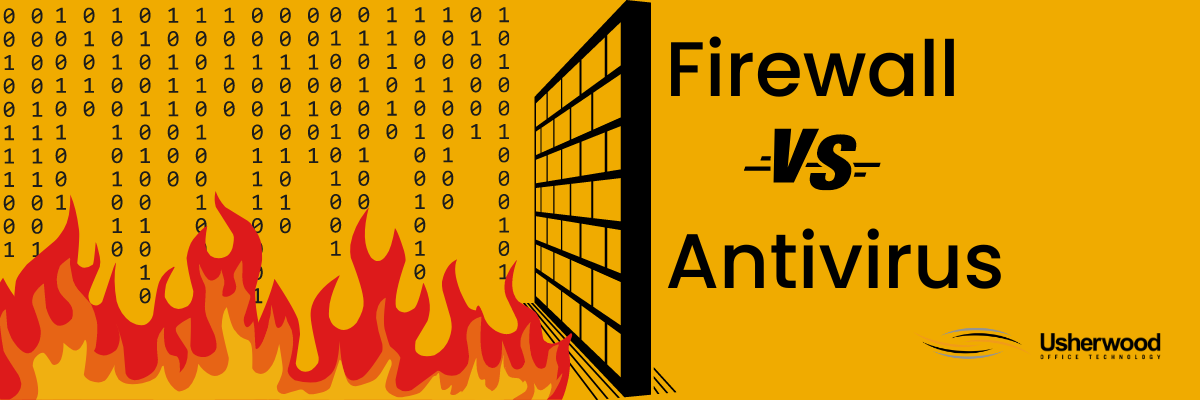By: Jada Sterling, Digital Content Manager on January 24th, 2024
The Difference Between Antivirus and Firewall Security
There are so many tools on the market that claim to protect your network from cyberattacks. In the digital age as tools progress quickly, it can be difficult to discern the difference between technical terms. You might wonder, “What’s a firewall?” and “How is that different from what antivirus does?”.
If you wonder about these things, you’re not alone. Here are the key similarities and differences between firewall and antivirus software, and some updated strategies to mitigate the risk of cyber breaches.
Is a Firewall an Antivirus? If Not, What is It?
A firewall works to monitor and control incoming and outgoing traffic on your network. It acts to prevent external threats from gaining access to your system while allowing for outward communication. It’s not the same thing as antivirus software, which scans your network for malware and malicious code.
Types of firewalls include:
- Proxy firewall
- Stateful inspection firewall
- Unified Threat Management (UTM) firewall
- Next Generation Firewall (NGFW)
- Threat-focused firewall
- Virtual firewall
- Cloud-Native firewall
Not all firewalls are created the same, and many serve different purposes. For example, a stateful inspection firewall is designed to filter traffic based on attributes set by the administrator or by a pre-defined security policy.
A Next Generation Firewall (NGFW) on the other hand, uses technology that goes beyond packet filtering and stateful inspection. This kind of firewall will include additional threat detection and remediation features that are better at spotting malicious software.
What is the Role of a Firewall in Network Security?
The term “firewall” originates from physical walls that prevent the spread of fire from one part of a building to another. It acts as a barrier, blocking out any unwanted hazards, just like a cybersecurity firewall. The role of a firewall in protecting your business is by filtering out any threats to your security, while allowing authorized users to access it.
What is Antivirus?
Unlike the data packet filtering with a firewall, antivirus is a cybersecurity tool that scans your network for code that it recognizes as malware or otherwise malicious. This is a slightly outdated form of cybersecurity, since zero-day attacks make it much less effective. Zero-day attacks refer to cyberattack methods that are brand new and unrecognized by even the most current antivirus software.
The Evolution of Antivirus to Endpoint Detection and Response
New cyber attacks change every year, constantly rendering antivirus protection outdated since software patches can't keep up. That’s why cybersecurity experts started using AI technology for endpoint security.
AI has the capability to spot and remediate irregular code that might indicate a zero-day attack. This method of threat mitigation is called Endpoint Detection and Response (EDR). As a more advanced technology than antivirus, EDR is becoming a standard for businesses to protect their assets.
To learn more about the key differences between EDR and antivirus, check out our blog: EDR vs Enterprise Antivirus: What’s the Difference?
Do Antivirus Programs or Firewalls Protect Against Hackers?
Both antivirus software and firewalls can mitigate the threat of hackers accessing your network. The key difference in how they defend against hackers. Firewalls can filter out unauthorized data packets and detect intrusions, while antivirus can scan for specific malicious software and code from websites, emails, and downloads
While both can help mitigate the threat of cyber attacks, the use of firewalls in combination with EDR technology is more universally recommended than antivirus.
Make a Comprehensive Cybersecurity Plan
A great way to be prepared for zero-day attacks and all of the scams that target businesses is to make a cybersecurity plan. With the help of your MSP, define the tools and action steps you can take to help protect your business. This plan should include industry best practices and the most current tools that are equipped for modern threats.
Zero Trust Architecture
Zero Trust is a cybersecurity framework that assumes all users and programs are untrustworthy unless deemed safe by a member of your IT team. This will place stops all throughout your network, which is a great way to stop hackers in their tracks before they can gain access to your assets.
This might look like blocking users from downloading unknown software, or requiring admin passwords to access sensitive data. It’s like locking every door within a castle instead of just creating a moat around the perimeter.
This is an effective deterrent for hackers, who will likely move on to an easier target once they’ve had enough barriers to entry. That’s why organizations like the National Institute of Standards and Technology(NIST) lists zero trust architecture as a recommended best practice for cybersecurity.
To read more about what zero trust is and how you can implement it, read our blog: “Zero Trust Is a Must to Combat Shadow IT, Zero-Day Attacks And More.”
EDR Security
It might surprise you how many of your devices could be vulnerable to cyber attacks. In the digital age, the digitization of everything from printers to refrigerators has made it easier than every for cybercriminals to find and exploit security vulnerabilities. That’s why it’s crucial to invest in office technology that is secure by design, meaning they are created with cybersecurity as a native feature.
There are multi-function printers (MFPs) on the market with EDR-like technology, which can detect and respond to malicious code including zero-day attacks. HP has released devices with these unique features, and you can read more about their strides in endpoint security in our blog: “How HP Printers and Toner Cartridges Will Drastically Improve Your Printer Security."
Other Best Practices in Cybersecurity
As a part of your cybersecurity strategy, it’s important to implement other best practices including:
- Multifactor Authentication (MFA)
- Strong passwords
- Frequent password resets
- Phishing awareness training for employees
To read more about the steps you can take to implement these strategies, read our article Ask the Expert: 7 Cybersecurity Essentials To Check Off..
Partner With An MSP With the Tools To Secure Your Network
Ask your MSP about the tools they use for endpoint security and mitigating malware threats. A quality MSP will give you the guidance to decide on the right mix of cybersecurity tools for your network security needs.
If you want to learn about how to better protect your business and mitigate the threat of cyberattacks, click the button below to speak to a cybersecurity professional.
Read On

EDR vs Enterprise Antivirus: What’s the Difference?
Every year, cybercriminals invent new ways to attack business servers. Most businesses focus...

Data Protection vs Data Security
Since the sharp rise of cyberattacks against businesses following the pandemic, data privacy is...

MSP vs MSSP: What’s the Difference?
If you're looking for IT outsourcing, you might be confused by all the acronyms used by different...




